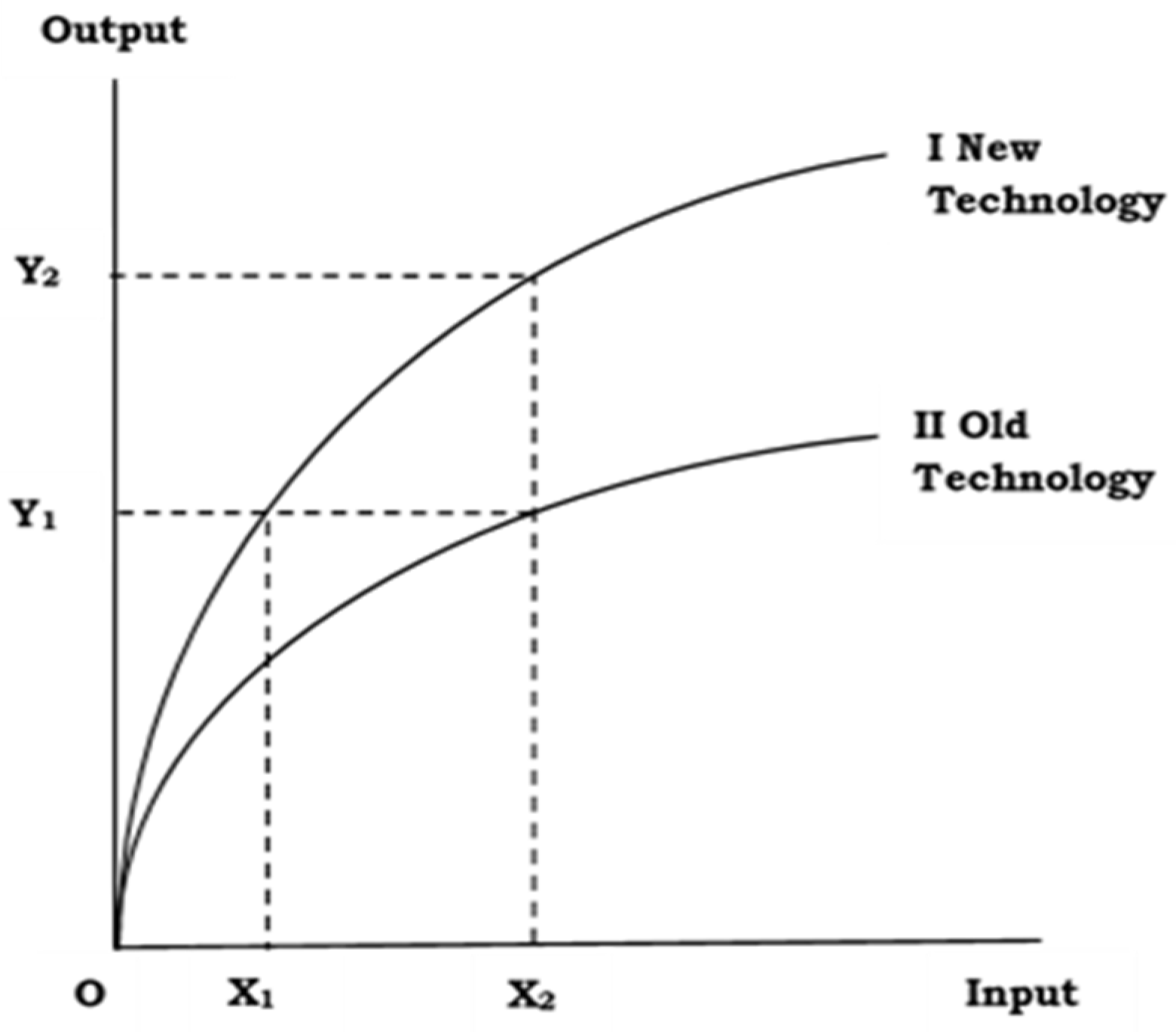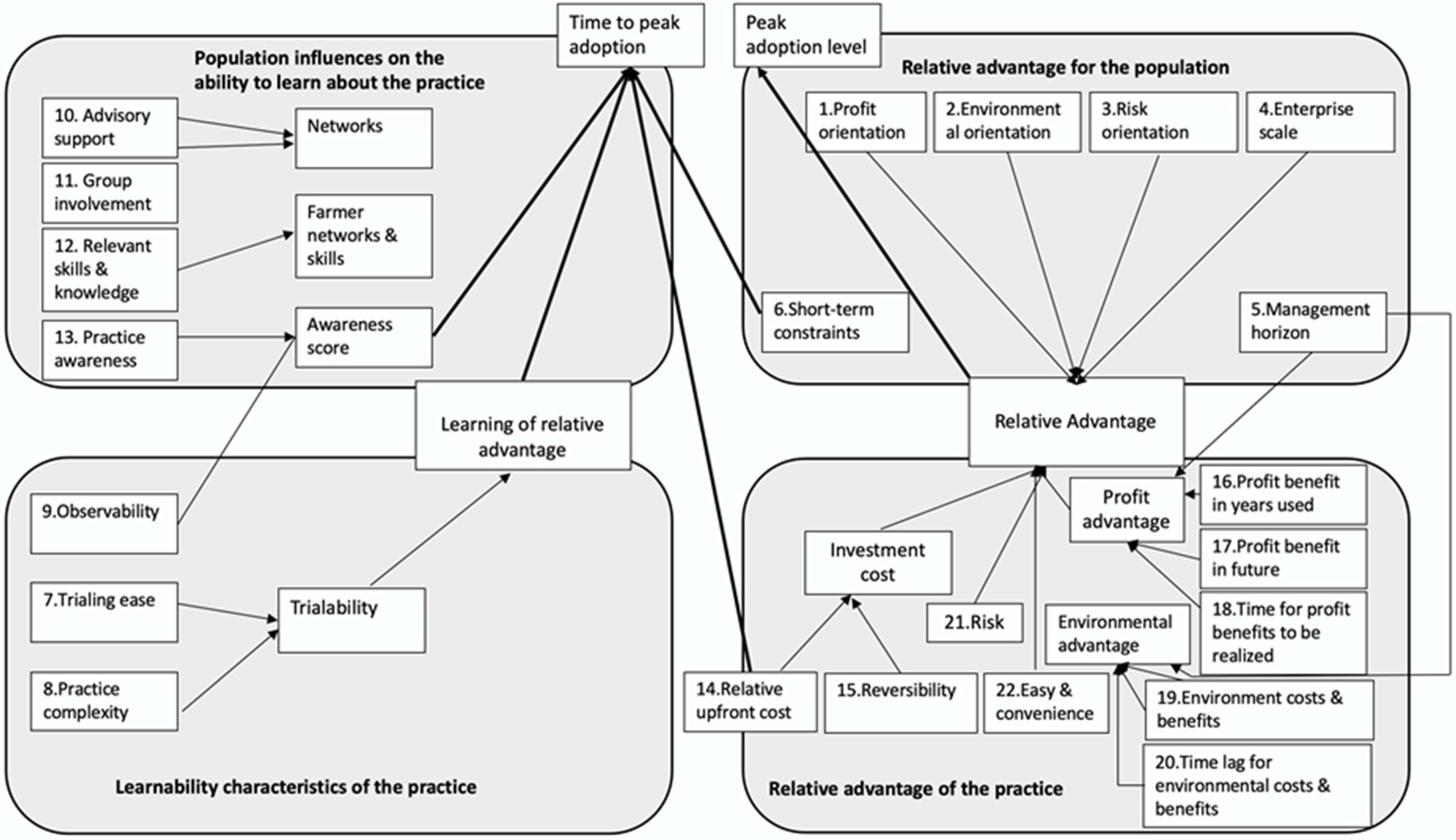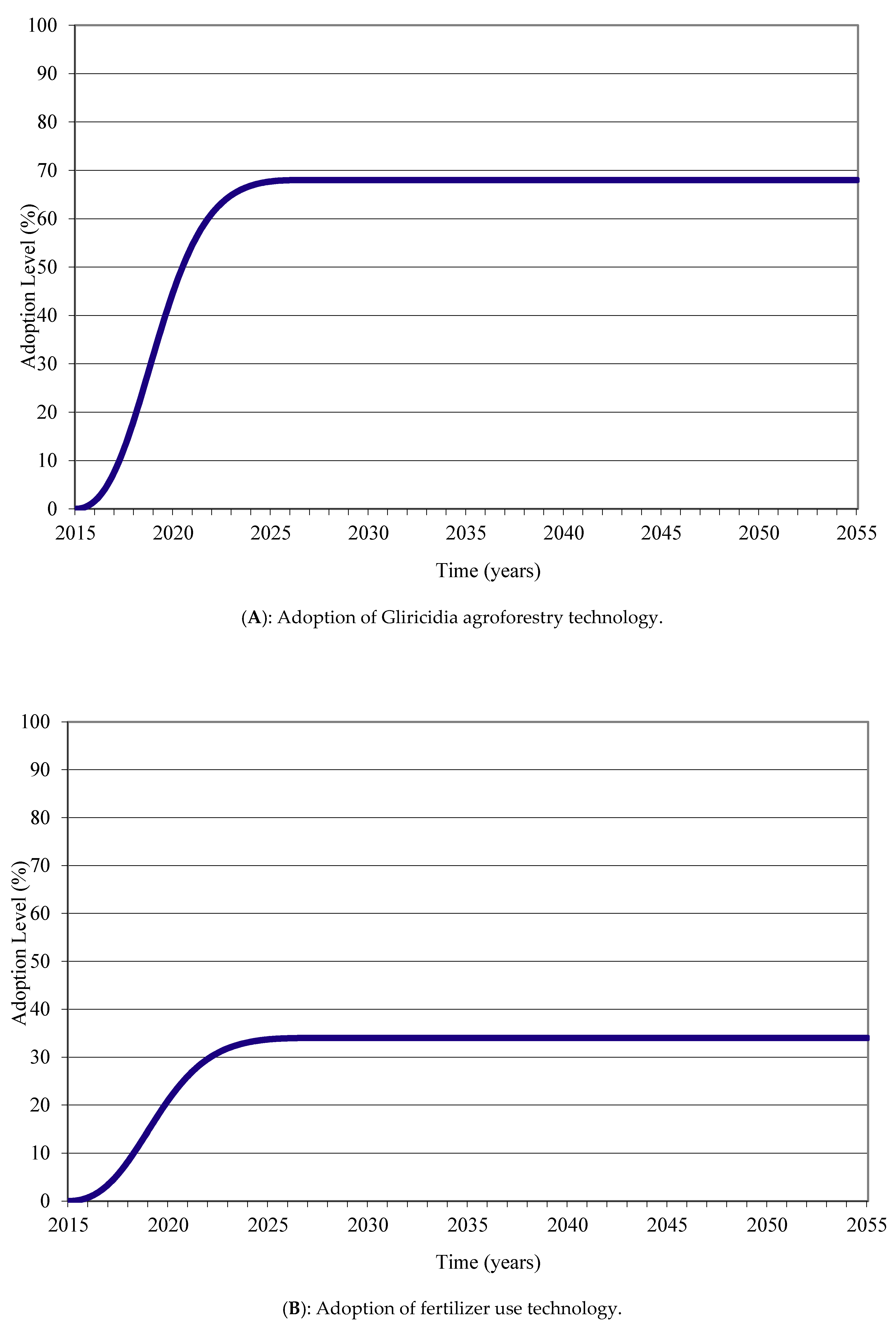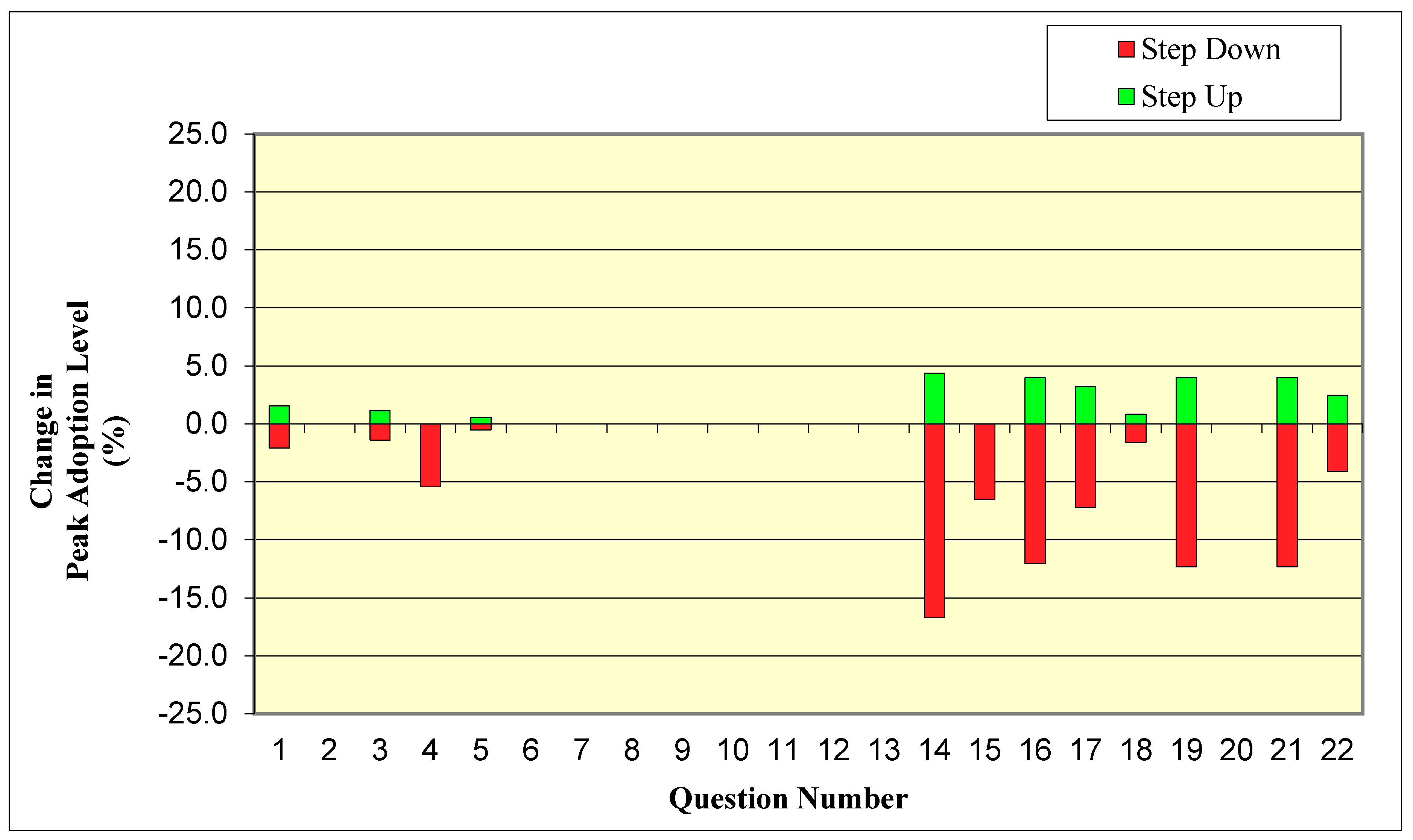Gliricidia Agroforestry Technology Adoption Potential in Selected Dryland Areas of Dodoma Region, Tanzania
Abstract
:1. Introduction
2. Methodology
2.1. Theoretical Framework
2.2. Nature of Technology Change
2.3. Empirical Review
2.4. Conceptual Framework
2.5. Sampling and Data Collection
Data Coding and Entry
2.6. Data Analysis
3. Results and Discussion
3.1. Adoption and Diffusion Model Results
3.2. Sensitivity Analysis Results
3.3. Conclusions and Recommendations
Author Contributions
Funding
Acknowledgments
Conflicts of Interest
References
- Sanchez, P.A. Soil fertility and hunger in Africa. Science 2002, 295, 2019–2020. Available online: http://citeseerx.ist.psu.edu/viewdoc/downloaddoi=10.1.1.362.6021&rep=rep1&type=pdf (accessed on 14 March 2018). [CrossRef] [PubMed] [Green Version]
- Vanlauwe, B.; Giller, K.E. Popular myths around soil fertility management in sub-Saharan Africa. Agric. Ecosyst. Environ. 2006, 116, 34–46. [Google Scholar] [CrossRef]
- Makurira, H.; Savenije, H.H.G.; Uhlenbrook, S.; Rockström, J.; Senzanje, A. The effect of system innovations on water productivity in subsistence rainfed agricultural systems in semiarid Tanzania. Agric. Water Manag. 2011, 98, 1696–1703. [Google Scholar] [CrossRef]
- MAFAP. Review of food and agricultural policies in the United Republic of Tanzania 2005–2011, July. In MAFAP Country Report Series; FAO: Rome, Italty, 2013. [Google Scholar]
- Mwinuka, L.; Mutabazi, K.D.; Graef, F.; Sieber, S.; Makindara, J.; Kimaro, A.; Uckert, G. Simulated willingness of farmers to adopt fertilizer micro-dosing and rainwater harvesting technologies in semi-arid and sub-humid farming systems in Tanzania. Food Secur. 2017, 9, 1237–1253. [Google Scholar] [CrossRef]
- Kimaro, A.A.; Weldesemayat, S.G.; Mpanda, M.; Swai, E.; Kayeye, H.; Nyoka, B.I.; Kundhlande, G. Evidence-Based Scaling-Up of Evergreen Agriculture for Increasing Crop Productivity, Fodder Supply and, Resilience of the Maize-Mixed and Agro-Pastoral Farming Systems in Tanzania and Malawi. In Project Reports, Studies and Working Papers, 2012. Available online: https://cgspace.cgiar.org/bitstream/handle/10568/69125/ar_esa_evergreen.pdf?sequence=1 (accessed on 10 May 2018).
- Kangalawe, R.Y.M.; Lyimo, J.G. Climate Change, Adaptive Strategies, and Rural Livelihoods in Semi-arid Tanzania. Nat. Resour. 2013, 4, 266–278. [Google Scholar]
- Coulibaly, Y.J.; GMango, J.; Swamila, M.; Kundhlande NAmos Tall, A.; Kaur, H.; Hansen, J. What Climate Service do Farmers and Pastoralists Need in Tanzania? Baseline Study for the GFCS Adaptation Program in Africa. CCAFS Working Paper No. 110; CGIAR Research Program on Climate Change, Agriculture and Food Security (CCAFS): Copenhagen, Denmark, 2015; Available online: www.ccafs.cgiar.org (accessed on 7 March 2019).
- Kwesiga, F.R.; Franzel, S.; Place, F.; Phiri, D.; Simwanza, C.P. Sesbania sesban improved fallows in eastern Zambia: Their inception, development and farmer enthusiasm. Agrofor. Syst. 1999, 47, 49–66. [Google Scholar] [CrossRef]
- Ajayi, O.C.; Akinnifesi, F.K.; Sileshi, G.; Kanjipite, W. Labour inputs and financial profitability of conventional and agroforestry-based soil fertility management practices in Zambia. Agrekon 2009, 48, 276–292. [Google Scholar] [CrossRef]
- Phiri, D.; Franzel, S.; Mafongoya, P.; Jere, I.; Katanga, R.; Phiri, S. Who is using the new technology? The association of wealth status and gender with the planting of improved tree fallows in Eastern Province, Zambia. Agric. Syst. 2004, 79, 131–144. [Google Scholar] [CrossRef]
- Keil, A.; Zeller, M.; Franzel, S. Improved fallows in smallholder maize production in Zambia: Do initial testers adopt the technology? Agrofor. Syst. 2005, 64, 225–236. [Google Scholar] [CrossRef]
- Kimaro, A.A.; Jonas, E.; Swai, E.; Rubanza, C.; Martha, S.; Ganga Rao, N.V.P.R.; Okori, P. Gliricidia-Based Doubled Up Legume for Improving Crop Production and Agroecosystem Resilience in Kongwa and Kiteto Districts, Dokumen 2017. Available online: https://dokumen.tips/science/gliricidia-based-doubled-up-legume-for-improving-crops-production-and-agroecosystem.html (accessed on 13 December 2019).
- Franzel, S. Socioeconomic factors affecting the adoption potential of improved tree fallows in Africa. Agrofor. Syst. 1999, 47, 305–321. [Google Scholar] [CrossRef]
- Pannell, D.J.; Marshall, G.R.; Barr, N.; Curtis, A.; Vanclay, F.; Wilkinson, R. Understanding and promoting adoption of conservation practices by rural landholders. Aust. J. Exp. Agric. 2006, 46, 1407–1424. [Google Scholar] [CrossRef] [Green Version]
- Valdivia, C.; Barbieri, C.; Gold, M.A. Between forestry and farming: Policy and environmental implications of the barriers to agroforestry adoption. Can. J. Agric. Econ. Rev. Can. D’agroecon. 2012, 60, 155–175. [Google Scholar] [CrossRef]
- Uckert, G.; Graef, F.; Faße, A.; Herrmann, L.; Hoffmann, H.; Kahimba, F.C.; Makoko, B. ScalA-FS: Expert-based ex-ante assessments of local requirements and success potential of upgrading strategies for improving food security in rural Tanzania. Food Secur. 2018, 10, 841–858. [Google Scholar] [CrossRef]
- Andrew, R.; Makindara, J.; Mbaga, S.H.; Alphonce, R. Ex-Ante Analysis of Adoption of Introduced Chicken Strains Among Smallholder Farmers in Selected Areas of Tanzania. In Proceedings of the International Conference on Social Implications of Computers in Developing Countries, Dar-es-Salaam, Tanzania, 1–3 May 2019; Springer: Cham, Switzerland, 2019; pp. 436–447. [Google Scholar]
- Monjardino, M.; Philp, J.N.M.; Kuehne, G.; Phimphachanhvongsod, V.; Sihathep, V.; Denton, M.D. Quantifying the value of adopting a post-rice legume crop to intensify mixed smallholder farms in Southeast Asia. Agric. Syst. 2020, 177, 102690. [Google Scholar] [CrossRef]
- Kuehne, G.; Llewellyna, R.; Pannell, B.; Wilkinsonc, R.; Dollingd, P.J.; Ouzmana, J.; Ewinge, M. Predicting farmer uptake of new agricultural practices: A tool for research, extension, and policy. J. Elsevier Agric. Syst. 2017, 156, 115–125. [Google Scholar] [CrossRef]
- Rogers, E.M. Diffusion of Innovations, 5th ed.; Free Press: New York, NY, USA, 2003. [Google Scholar]
- Kuehne, G.; Llewellyn, R.; Pannell, D.; Wilkinson, R.; Dolling, P.; Ewing, M. ADOPT: A tool for predicting adoption of agricultural innovations. In Proceedings of the 55th Annual National Conference of the Australia Agricultural & Resources Economics Society, Melbourne, Victoria, Australia, 8–11 February 2011. [Google Scholar]
- Wigboldus, S.; Klerkx, L.; Leeuwis, C.; Schut, M.; Muilerman, S.; Jochemsen, H. Systemic perspectives on scaling agricultural innovations. A review. Agron. Sustain. Dev. 2016, 36, 1–20. [Google Scholar] [CrossRef] [Green Version]
- Thornton, P.K.; Schuetz, T.; Förch, W.; Cramer, L.; Abreu, D.; Vermeulen, S.; Campbell, B.M. Responding to global change: A theory of change approach to making, agricultural research for development outcome-based. Agric. Syst. 2017, 152, 145–153. [Google Scholar] [CrossRef]
- Bass, F.M. A new product growth for model consumer durables. Manag. Sci. 1969, 15, 215–227. [Google Scholar] [CrossRef]
- Yengoh, G.T.; Armah, F.A.; Svensson, M.G. Technology adoption in small-scale agriculture. Humanit. Dev. 2010. [Google Scholar] [CrossRef]
- Shideed, K.H.; El Mourid, M. Adoption and impact assessment of improved technologies in crop and livestock production systems in the WANA region. In The Development of Integrated Crop/Livestock Production in Low Rainfall Areas of Mashreq and Maghreb Regions (Mashreq/Maghreb Project); ICARDA: Aleppo, Syria, 2005. [Google Scholar]
- Pfister, F.; Bader, H.P.; Scheider, R.; Buccini, P. Dynamic modeling of resource management for farming systems. Agric. Syst. 2005, 86, 1–28. [Google Scholar] [CrossRef]
- Amir, K.; Ghadim, A.; Pannell, D.J. A conceptual framework of adoption of an agricultural innovation. Agric. Econ. 1999, 21, 145–154. [Google Scholar]
- Kaliba, A.R.M.; Verkuijl, W.; Mwangi, A.J.T.; Mwilawa, P.; Anandajayasekeram, H.; Moshi, A.J. Adoption of Maize Production Technologies in Central Tanzania. Interna-tional Maize and Wheat Improvement Center (CIMMYT), the United Republic of Tanzania, and the Southern Africa Centre for Cooperation in Agricultural Research (SACCAR) 1998. Available online: http://www.tanzaniagateway.org (accessed on 21 September 2018).
- Simtowe, F.; Kassie, M.; Diagne, A.; Asfaw, S.; Shiferaw, B.; Silim, S.; Muange, E. Determinants of agricultural technology adoption: The case of improved pigeonpea varieties in Tanzania. Q. J. Int. Agric. 2011, 50, 325–345. [Google Scholar]
- Pedersen, K.E. Factors Affecting the Adoption of Improved Banana Technologies in Northern Tanzania; Rockwool Foundation Research Unit: Copenhagen, Denmark, 2012. [Google Scholar]
- Kinuthia, B.K.; Mabaya, E. The Impact of Agricultural Technology Adoption on Farmer Welfare in Uganda and Tanzania. 2017. Available online: https://editorialexpress.com/cgi-bin/conference/download.cgi?db_name=CSAE2017&paper_id=981 (accessed on 19 July 2019).
- Adesina, A.A. Factors affecting the adoption of fertilizers by rice farmers in Cote d’Ivoire. Nutr. Cycl. Agroecosyst. 1996, 46, 29–39. [Google Scholar] [CrossRef]
- Namwata, B.M.L.; Lwelamira, J.; Mzirai, O.B. Adoption of improved agricultural technologies for Irish potatoes (Solanum tuberosum) among farmers in Mbeya rural district, Tanzania: A case of Ilungu ward. J. Anim. Plant Sci. 2010, 8, 927–935. Available online: http://www.m.elewa.org/JAPS/2010/8.1/4.pdf (accessed on 19 August 2018).
- Kahimba, F.C.; Mutabazi, K.D.; Tumbo, S.D.; Masuki, K.F.; Mbungu, W.B. Adoption and scaling-up of conservation agriculture in Tanzania: Case of Arusha and Dodoma regions. J. Nat. Resour. 2014, 5, 161–1765. [Google Scholar] [CrossRef] [Green Version]
- Senkondo, E.M.M.; Lazaro, E.A.; Kajiru, G.J. Adoption of rainwater harvesting technologies by farmers in Tanzania with particular reference to the Western, Pare Lowlands. Tanzan. J. Agric. Sci. 1999, 2, 205–218. [Google Scholar]
- Adesina, A.A.; Coulibaly, O.N. Policy and competitiveness of agroforestry-based technologies for maize production in Cameroon: An application of policy analysis matrix. Agric. Econ. 1998, 19, 1–13. [Google Scholar]
- Jamala, G.Y.; Shehu, H.E.; Yidau, J.J.; Joel, L. Factors influencing adoption of agroforestry among smallholder farmers in Toungo, Southeastern, Adamawa State, Nigeria. IOSR J. Environ. Sci. Toxicol. Food Technol. 2013, 6, 66–72. [Google Scholar]
- Lesser, W.; Bernard, J.; Billah, K. Methodologies for ex-ante projections of adoption rates for biotech products: Lessons learned from rBST. Agribus. Int. J. 1999, 15, 149–162. [Google Scholar] [CrossRef]
- Kaine, G.; Wright, V.; Cooksey, R.; Bewsell, D. Identifying potential adopters of an agricultural innovation. In Changing Land Management: Adoption of New Practices by Rural Landholders; Pannell, D., Vanclay, F., Eds.; CSIRO: Collingwood, Australia, 2011; p. 69. [Google Scholar]
- Karali, E.; Brunner, B.; Doherty, R.; Hersperger, A.; Rounsevell, M. Identifying the factors that influence farmer participation in environmental management practices in Switzerland. Hum. Ecol. 2014, 42, 951–963. [Google Scholar] [CrossRef]
- Pope, R.D. Expected profit, price change, and risk aversion. Am. J. Agric. Econ. 1982, 64, 581–584. [Google Scholar] [CrossRef]
- Haynie, A.C.; Layton, D.F. An expected profit model for monetizing fishing location choices. J. Environ. Econ. Manag. 2010, 59, 165–176. [Google Scholar] [CrossRef]
- Ferguson, M.E.; Fleischmann, M.; Souza, G.C. A profit-maximizing approach to disposition decisions for product returns. Decis. Sci. 2011, 42, 773–798. [Google Scholar] [CrossRef]
- Dearing, J.W.; Meyer, G. An exploratory tool for predicting adoption decisions. Sci. Commun. 1994, 16, 43–57. [Google Scholar] [CrossRef]
- Pannell, D.J.; Llewellyn, R.S.; Corbeels, M. The farm-level economics of conservation agriculture for resource-poor farmers. Agric. Ecosyst. Environ. 2014, 187, 52–64. [Google Scholar] [CrossRef]
- Champ, B.R.; Highley, E.; Remenyi, J.V. Technological Change in Postharvest Handling and Transportation of Grains in the Humid Tropics: Proceeding of an...; No. 338.160913 T255t; Australian Centre for International Agricultural Research: Canberra, AU, 1987. [Google Scholar]
- Marsh, S.; Pannell, D.; Lindner, R. The impact of agricultural extension on adoption and diffusion of lupins as a new crop in Western Australia. Aust. J. Exp. Agric. 2000, 40, 571–583. [Google Scholar] [CrossRef]
- Bundala, N.H.; Kinabo, J.; Jumbe, T.; Rybak, C.; Stuetz, W.; Sieber, S. A Tailored Nutrition Education Intervention Improves Women’s Nutrition Knowledge and Dietary Practices in Farming Households of Tanzania. J. Nutr. Health Food Sci. 2020, 8, 1–13. [Google Scholar]
- Makumba, W.; Janssen, B.; Oenema, O.; Akinnifesi, F.K.; Mweta, D.; Kwesiga, F. The long-term effects of a gliricidia–maize intercropping system in Southern Malawi, on gliricidia and maize yields, and soil properties. Agric. Ecosyst. Environ. 2006, 116, 85–92. [Google Scholar] [CrossRef]
- CIMMYT. The Adoption of Agricultural Technology: A Guide for Survey Design; Economics Program, International Maize and Wheat Improvement Center: Mexico City, Mexico, 1993. [Google Scholar]
- De Acedo Lizárraga, M.L.S.; de Acedo Baquedano, M.T.S.; Cardelle-Elawar, M. Factors that affect decision making: Gender and age differences. Int. J. Psychol. Psychol. Ther. 2007, 7, 381–391. [Google Scholar]
- Folch-Lyon, E.; Trost, J.F. Conducting focus group sessions. Stud. Fam. Plan. 1981, 12, 443–449. [Google Scholar] [CrossRef] [Green Version]
- Shafritz, L.B.; Roberts, A. The value of focus-group research in targeting communication strategies: An immunization case study. Health Transit. Rev. 1994, 4, 81–85. [Google Scholar] [PubMed]
- Nyumba, O.T.; Wilson, K.; Derrick, C.J.; Mukherjee, N. The use of focus group discussion methodology: Insights from two decades of application in conservation. Methods Ecol. Evol. 2018, 9, 20–32. [Google Scholar] [CrossRef] [Green Version]
- Dixon, R. Hybrid corn revisited. Econometrica 1980, 48, 1451–1462. [Google Scholar] [CrossRef]
- Feder, G.; O’Mara, G. On information and innovation diffusion: A Bayesian approach. Am. J. Agric. Econ. 1982, 64, 145–147. [Google Scholar] [CrossRef]
- Jensen, R. Adoption and diffusion of an innovation of uncertain profitability. J. Econ. Theory 1982, 27, 182–193. [Google Scholar] [CrossRef]
- Ellis, F. Peasant Economics: Farm Households in Agrarian Development; Cambridge University Press: London, UK, 1993; Volume 23. [Google Scholar]
- Jose, S. Agroforestry for ecosystem services and environmental benefits: An overview. Agrofor. Syst. 2009, 76, 1–10. [Google Scholar] [CrossRef]
- Kimaro, A.A.; Mpanda, M.; Rioux, J.; Aynekulu, E.; Shaba, S.; Thiong’o, M.; Mutuo, P.; Abwanda, S.; Shepherd, K.; Neufeldt, H.; et al. Is conservation agriculture ‘climate-smart’for maize farmers in the highlands of Tanzania? Nutr. Cyc. Agroecosyst. 2016, 105, 217–228. [Google Scholar] [CrossRef]
- Kimaro, A.A.; Sererya, O.G.; Matata, P.; Uckert, G.; Hafner, J.; Graef, F.; Rosenstock, T.S. Understanding the multidimensionality of climate-smartness: Examples from agroforestry in Tanzania. In The Climate-Smart Agriculture Papers; Springer: Cham, Switzerland, 2019; pp. 153–162. [Google Scholar]
- Thangata, P.H.; Alavalapati, J.R.R. Agroforestry adoption in southern Malawi: The case of mixed intercropping of Gliricidia sepium and maize. Agric. Syst. 2003, 78, 57–71. [Google Scholar] [CrossRef]
- Haggblade, S.; Tembo, G.; Donovan, C. Household level financial incentives to adoption of conservation agricultural technologies in Africa. AgEcon Search 2004. No. 1093-2016-88043. [Google Scholar] [CrossRef]
- Kangile, R.J.; Mgeni, C.P.; Mpenda, Z.T.; Sieber, S. The Determinants of Farmers’ Choice of Markets for Staple Food Commodities in Dodoma and Morogoro, Tanzania. Agriculture 2020, 10, 142. [Google Scholar] [CrossRef]
- Akroush, S.; Dhehibi, B. Predicted willingness of farmers to adopt water harvesting technologies: A case study from the Jordanian Badia (Jordan). Am. Eurasian J. Agric. Environ. Sci. 2015, 15, 1502–1513. [Google Scholar]





| S/N | Variables | Question Asked | Measurement (Likert Scale: Statement of Minimum and Maximum Wording) | ADOPT Inputs/Mean Scores | |
|---|---|---|---|---|---|
| Agroforestry | Fertilizer | ||||
| 1 | Profit orientation | What proportion of the target population has maximizing profit as a strong motivation? | Almost none (1), almost all (5) have profit maximization motive | 4 | 4 |
| 2 | Environmental orientation | What proportion of the target population has protecting the natural environment as a strong motivation? | Almost none (1), almost all (5) have protection of environment motive | 3 | 3 |
| 3 | Risk orientation | What proportion of the target population has risk minimization as a strong motivation? | Almost none (1), almost all (5) have risk minimization motive | 2 | 2 |
| 4 | Enterprise scale | On what proportion of the target farms is there a major enterprise that could benefit from the practice? | Almost none (1), almost all (5) of the target farms have major enterprise that could benefit | 3 | 3 |
| 5 | Management horizon | What proportion of the target population has a long-term (greater than 10 years) management horizon for their farm? | Almost none (1), almost all (5) have long-term management horizon for their farms | 3 | 3 |
| 6 | Short term financial constraints | What proportion of the target population is under conditions of severe short-term financial constraints? | Almost all (1), almost none (5) have severe short-term financial constraints | 2 | 2 |
| 7 | Easiness in trialing | How easily can the practice (or significant components of it) be trialed on a limited basis before a decision is made to adopt it on a larger scale? | Not triable at all (1), very triable (5) | 3 | 3 |
| 8 | Innovation complexity | Does the complexity of the practice allow the effects of its use to be easily evaluated when it is used? | Very difficult (1), not at all difficult (5) to evaluate the effects of its use | 4 | 4 |
| 9 | Observability | To what extent would the practice be observable to farmers who are yet to adopt it when it is used in their district? | Not observable at all (1), very easily observable (5) | 4 | 4 |
| 10 | Advisory support | What proportion of the target population uses paid advisors capable of providing advice relevant to the practice? | Almost none (1), almost all (5) use a relevant advisor | 3 | 3 |
| 11 | Group involvement | What proportion of the target population participates in farmer-based groups that discuss farming? | Almost none (1), almost all (5) are involved in a group that discusses farming | 2 | 2 |
| 12 | Relevant existing skills and knowledge | What proportion of the community will need to develop substantial new skills and knowledge to use the practice? | Almost all (1), almost none (5) need new skills and knowledge | 3 | 3 |
| 13 | Awareness on the use/trialing of the innovation in the district | What proportion of the community would be aware of the use or trialing of the practice in their district? | It has never been used (1), almost all (5) are aware that it has been used/tried | 2 | 1 |
| 14 | Relative upfront cost of innovation | What is the size of the up-front cost of the investment relative to the potential annual benefit from using the practice? | Very large (1), no (5) initial investment required | 3 | 4 |
| 15 | Reversibility of the innovation | To what extent is the adoption of the practice able to be reversed? | Not reversible (1), very easily revised (5) | 3 | 4 |
| 16 | Profit benefits in the years that it is used | To what extent is the use of the practice likely to affect the profitability of the farm business in the years that it is used? | Large profit disadvantage (-3), very large profit advantage (+4) | 3 | 4 |
| 17 | Profit benefit in future | To what extent is the use of the practice likely to have additional effects on the future profitability of the farm business? | Large profit disadvantage (-3), very large profit advantage (+4) | 4 | 3 |
| 18 | Time for profit/benefits to be realized | How long after the practice is first adopted would it take for effects on future profitability to be realized? | More than 10 years (16), immediately (1) | 2 | 1 |
| 19 | Environmental impact | To what extent would the use of the practice have net environmental benefits or costs? | Large environmental disadvantage (-3), very large environmental advantage (+4) | 4 | 2 |
| 20 | Time for environmental impact to be realized | How long after the practice is first adopted would it take for the expected environmental benefits or costs to be realized? | More than 10 years (16), immediately (1) | 2 | 1 |
| 21 | Risks exposure | To what extent would the use of the practice affect the net exposure of the farm business to risk? | Large increase (-3), very large reduction in risk | 3 | 1 |
| 22 | Ease and convenience | To what extent would the use of the practice affect the ease and convenience of the management of the farm in the years that it is used? | Large decrease (-3), a very large increase in easy and convenience (+4) | 2 | 3 |
| Peak Adoption |
|---|
| Profit advantage = (Profit benefit in years used + Profit benefit in future × (1 + Discount rate)−Years to Future Profit Benefit)/2 |
| Environmental benefit = web × Environmental benefit × (1+Discount rate)-Years to environmental benefit |
| Discount rate = 0.02 if Almost all have a long-term management horizon; 0.04 if A majority have a long term management horizon; 0.06 if About half have a long term management horizon; 0.08 if A Minority have a long-term management horizon; 0.1 if Almost none have a long-term management horizon. |
| Relative advantage = [(1 + wp × Profit orientation) × Profit advantage + (1 + wr × Risk orientation) × Risk + Ease and convenience + (1 + we × Environmental orientation) × Environmental advantage] × (1 + wes × Enterprise scale) + wic × (Investment cost – Max investment cost) |
| Peak adoption = Pmin +(Pmax- Pmin)/(1+EXP(cc – Relative advantage × cp)) |
| Time to Peak Adoption |
| Trialability of Practice = (Trialing ease + Practice complexity)/2 |
| Networks = Min (wgi × Group involvement + Advisory support, 7) |
| Learning of Relative Advantage = Trialability of practice + Farmer networks skills + wRA × Relative advantage |
| Awareness Score = Amin+ Practice awareness + Observability − Ao × Practice awareness × Observability |
| Farmer networks and skills = Fa + Fb × Relevant existing skills and knowledge + Fc × Networks + Fd × Relevant existing skills and knowledge × Networks |
| Time to peak adoption = MAX(Tmax − Learning of Relative Advantage × Lm + IF(UpfrontCosts ≥ 4, 0, Tmin − UpfrontCosts) + (Cmax − ShortTermConstraints) × ShortTermConstraints − AwarenessScore, 3) |
| wp | Profit Orientation Weight (0.4) | Cmax | Maximum Time Added Due to Short-Term Constraints (4) |
| wr | Risk orientation weight (0.2) | wia | Practice awareness weight (“0”) |
| we | Environmental weight (0.4) | wo | Observability weight (“0”) |
| wic | Investment cost weight (0.33) | Amin | Minimum level for awareness score (−1.25) |
| wes | Enterprise scale weight (0.4) | Ao | Weight on interaction between practice awareness and observability (0.15) |
| wre | Risk effect weight (0.6) | web | Environmental benefits weight (0.6) |
| Tmax | Maximum time to adoption (50) | wRA | Rescales RA score to have equal influence on learning as do Trialability and Farmer Networks and Skills |
| Tmin | Minimum time to adoption (3) | wgi* | Group involvement weight (0.7) |
| Pmin | Minimum adoption rate (1) | cc | Peak adoption curve parameter (3) |
| Pmax | Maximum adoption rate (98) | cp | Peak adoption curve parameter (0.3) |
| Fa | Intercept term for Farmer networks and skills (-0.63) | Fb | Weight on existing skills and knowledge (1.13) |
| Fc | Weight on networks (0.63) | Fd | Weight on interaction between networks and skills (−0.13) |
| Lm | Scalar of Learning of Relative Advantage Score (3.0) |
© 2020 by the authors. Licensee MDPI, Basel, Switzerland. This article is an open access article distributed under the terms and conditions of the Creative Commons Attribution (CC BY) license (http://creativecommons.org/licenses/by/4.0/).
Share and Cite
Swamila, M.; Philip, D.; Akyoo, A.M.; Sieber, S.; Bekunda, M.; Kimaro, A.A. Gliricidia Agroforestry Technology Adoption Potential in Selected Dryland Areas of Dodoma Region, Tanzania. Agriculture 2020, 10, 306. https://doi.org/10.3390/agriculture10070306
Swamila M, Philip D, Akyoo AM, Sieber S, Bekunda M, Kimaro AA. Gliricidia Agroforestry Technology Adoption Potential in Selected Dryland Areas of Dodoma Region, Tanzania. Agriculture. 2020; 10(7):306. https://doi.org/10.3390/agriculture10070306
Chicago/Turabian StyleSwamila, Martha, Damas Philip, Adam Meshack Akyoo, Stefan Sieber, Mateete Bekunda, and Anthony Anderson Kimaro. 2020. "Gliricidia Agroforestry Technology Adoption Potential in Selected Dryland Areas of Dodoma Region, Tanzania" Agriculture 10, no. 7: 306. https://doi.org/10.3390/agriculture10070306
APA StyleSwamila, M., Philip, D., Akyoo, A. M., Sieber, S., Bekunda, M., & Kimaro, A. A. (2020). Gliricidia Agroforestry Technology Adoption Potential in Selected Dryland Areas of Dodoma Region, Tanzania. Agriculture, 10(7), 306. https://doi.org/10.3390/agriculture10070306






